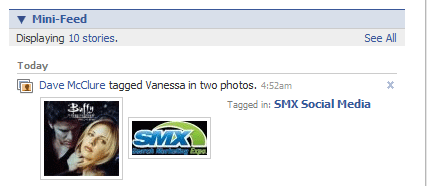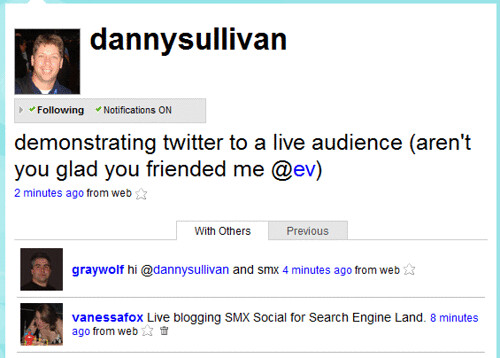Live Blogging: SMX Social Media – Effectively Leveraging Social Networking
It’s day two of Search Marketing Expo Social Media and first up is levering social networking. On this panel are Dave McClure of 500Hats, Cindy Krum of Blue Moon Works, and Helen M. Overland of Non-Linear Creations. We’re going to learn all about using Facebook, MySpace, and LinkedIn for customer engagement, branding, and driving traffic. […]
It’s day two of Search Marketing Expo Social Media and first up is levering social networking. On this panel are Dave McClure of 500Hats, Cindy Krum of Blue Moon Works, and Helen M. Overland of Non-Linear Creations. We’re going to learn all about using Facebook, MySpace, and LinkedIn for customer engagement, branding, and driving traffic.
See additional coverage at Search Engine Roundtable and Search Engine Journal.
Dave is up first to talk about Facebook. Danny says the next big thing is totally Hatebook. You can join hater groups and add the “top people you hate” app and compare what about each other you hate the most. Awesome.
Dave is talking about how you can share things (like photos and videos) with people on Facebook. If you want someone to see something, you can tag it with their name. I think this was originally intended for tagging people actually in the photo or video or note, but you can totally use it for spamming, I mean sharing. You can either send things directly or put them into your feed. I’ve never shared anything, so I really had no idea how to do any of this. Pretty slick, really. He’s tagged me in a couple of photos, and it’s showing up in both my news feed (which shows what’s going on with your friends) and my profile mini-feed (which shows what’s going on with me). Huh. There’s some Buffy person in this photo. I wonder why that might be…
You can use this cool Facebook toolbar to simply navigate to a site, then click the share button.
You can also create a group, for instance to promote an event, and invite all your friends to it. You can then share items within that group or send messages to everyone in it.
You might also experiment with your profile picture. Try making it a logo for your next event or product.
Helen is up next to talk about marketing on LinkedIn. It currently has 15 million users and the average income is $140k. (Or actually lots of people make less and a few make many millions and skew up the numbers.) LinkedIn lets you get in touch with not lots of people, but the few right people. You can access people who are two degrees away from your network.
LinkedIn has “open networkers” who have thousands of contacts. Add a few of those to your network and you’ll have access to thousands upon thousands of people. So look for them. They have a “LION” icon next to their profiles.
LinkedIn answers can help you gain visibility. You can show your expertise by answering questions and can include a link to your web site. You can drive readers to your blog this way by answering a question in a post then replying to the question with a link to it. You can also ask your clients to recommend you in LinkedIn services.
Helen notes that LinkedIn links aren’t nofollowed and that the pages are indexed. You can get traffic from direct LinkedIn users, from those finding the pages in the search results, and potentially from your own pages if the LinkedIn links boost your PageRank.
You can also get all of your employees to create profiles that link back to your site.
Cindy’s now up to talk about MySpace. Apparently there are good things about it, in addition to all the bad stuff. Who knew?
She is pulling up the profile of Flying Dog Brewery as an example of good usage. They are driving sales, as well as driving traffic to their brewery site. They’re using MySpace to interact with their target community. They’ve changed their profile picture to advertise an upcoming event and they include photo albums with their edgy labels that people might link to and share around.
You can set up events, invite people, have them RSVP, and then that will show up on the bulletin board of those people’s friends. You can also use MySpace to send mail to your audience. You may even be able to use this instead of using an email service provider or setting up an entire mail system. Let MySpace deal with all the technical parts of mail and just concentrate on the marketing part.
Cindy also notes that MySpace profiles can show up fairly high in search results. This is the third panel that’s mentioned using social networking profiles in reputation management. Maybe there’s something to this.
She shows the profile for True, which provides quizzes, calculators, fortunes, and other fun things that get the community engaged.
So what’s bad about MySpace? Other than all the blinking, I think she means. She mentions a community college that wanted to reach out to their students on MySpace. She said she wasn’t sure if it was right for the college, since they’re fairly traditional and not necessarily a MySpace kind of an organization.
Setting up the profile was a lot of work (you need to know CSS, for instance, to make a great looking page). They needed lots of unique content (how is this different from the main web site) and fresh content to keep people coming back.
Students started adding the college profile as a friend, but some of those student profiles had a different message than the college wanted to send. They originally only friended back non-offensive profiles, but profiles can change…
If you’re building up a company profile, you have to consider what “friends” you want to be associated with for branding purposes. And you need someone at the company who can engage with the audience: blogging, sending messages, being an actual member of the community.
You also need to have a strategy for how you will respond (if at all) to negative feedback. Of course, you need to consider a lot of these things in any case if you are operating at all in the online space.
Now we’re talking about links. Some links are encoded; some aren’t. Some may pass PageRank credit and others don’t. It depends on what section of the site they’re on. You can create apps for Facebook, but they have to be in Flash version 9 and Action Script version 3. Widgets are different from other types of apps and are pretty complex, based on how MySpace converts things. Get a developer who knows MySpace widget development specifically. MySpace may be launching a new developer platform soon, so watch for that.
Questions.
Do you keep LinkedIn as professional contacts or should you add other friends? Add everyone you know. You never know when that contact may help.
Is LinkedIn becoming more social? What are there future plans? You can add images to your profile, and they are opening up an API but will approve any developed apps (unlike Facebook that lets in any and all zombies and vampires).
How can you leverage apps on Facebook? Great customer acquisition opportunities. 20-50 apps have more than 1 million users. Most apps are lightweight and are great for engagement. Can you take advantage of the customer base you already have? Maybe seed your Facebook app with that group? Sure, if you have the right brand for Facebook. Games and entertainment are definitely well-suited to the environment.
What’s the MySpace demographic? Younger, although perhaps older than what people expect. 15-30, most likely. Is MySpace a waste of time for marketing? Is there too much spam? It is a lot of work, so make sure it’s right for your demographic. It’s not so much for SEO and more for creating relationships with your customers.
Dave is now talking about Facebook apps and notes that if you are using an app, your friends can’t see updates in their news feed about what you’re doing with that app unless they also have it installed. So it’s difficult to use the news feed to get new users to an app.
He thinks new monetization options are likely coming — perhaps even a self-serve model a la AdWords. Things are changing quickly with Facebook. It’s not unlike the early days of search engines.
Now I’m seeing my Twitter about live blogging on screen and we’re swirling into a vortex of a self-referential time paradox.
Now someone wonders if a company should leverage other social networks or create their own on their site using something like Ning. Larger sets of social networks already have users who are interacting, so you might just jump into that. But creating a branded community on your site might make sense. Keep in mind that users are getting social network fatigue and now that they’ve picked, they may not want to sign up for more.
Opinions expressed in this article are those of the guest author and not necessarily Search Engine Land. Staff authors are listed here.
Related stories

